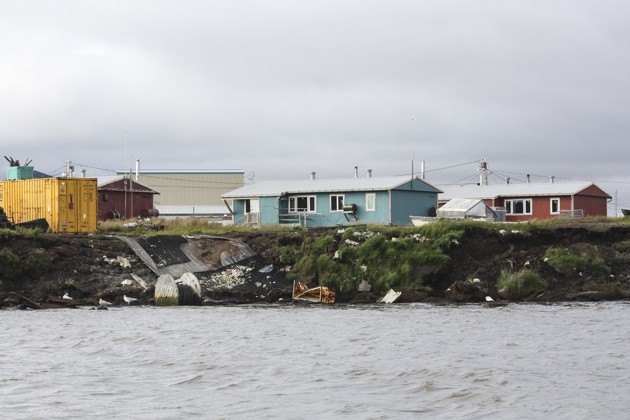Newtok: villaggio dell' Artico combatte per la sopravvivenza
Ogni anno milioni di persone sono costrette ad abbandonare i propri territori perché resi inabitabili dagli effetti del cambiamento climatico. Nel report del 2007 l’IPCC segnala come la crescita della temperatura media dell’Artico proceda ad un tasso due volte superiore rispetto al tasso medio globale degli ultimi cento anni; con la conseguente riduzione dei ghiacci artici e la perdita e degrado del territorio. Risultati confermati dagli studi condotti dall’Arctic Council e riportati nell’ Arctic Climate Impact Assesment (ACIA 2004). Degrado ambientale ed inquinamento che minacciano non solo le risorse rinnovabili ma anche la coltivazione e la pesca; causando problemi di salute e compromettendo la sopravvivenza delle generazioni future. Ad oggi gli impatti dei cambaimenti climatici sono così gravi da superare tutti i meccanismi di adattamento e non lasciare alle popolazioni colpite altra scelta che la migrazione temporanea o permanente.
Un caso esemplare è quello del villaggio di Newtok, situato nell’Alaska Occidentale lungo il fiume Ninglik e vicino al mare di Bering. Il villaggio si estende su un area di 2.8 km2 e conta una popolazione di 354 abitanti (secondo un censimento del 2010). Tale comunità è costretta al ricollocamento forzato a causa degli effetti del cambiamento climatico. In particolare a minacciare la sopravvivenza della comunità sono lo scioglimento del Permafrost (dovuto all’innalzamento delle temperature) e l’erosione. Lo scioglimento del Permafrost, l’erosione e l’innalzamento dei livelli del mare causano danni non solo alle infrastrutture ma anche alla rete fognaria e alle falde acquifere comportando una riduzione dell’acqua potabile disponibile. Il cambiamento climatico influenza anche l’habitat marino e terrestre e comporta una riduzione significativa degli stock ittici nonchè un cambiamento nei pattern migratori della fauna locale. Il ghiaccio marino costituisce una via di trasporto che connette le comunità e garantisce l’accesso ai terreni di caccia; tale strato però diventa sempre più fine a causa dell’innalzamento delle temperature rendendo gli spostamenti estremamente pericolosi. Queste comunità dipendono largamente dalla caccia e dalla pesca per l’approvvigionamento di cibo perciò la loro sicurezza alimentare è minacciata. Il ricollocamento forzato sembra l’unica soluzione per proteggere la comunità. Già a partire dal 1994 la comunità ha iniziato a valutare i possibili siti per un ricollocamento scegliendo Nelson Island. Il nuovo sito, che si trova a circa 14 chilometri, è stato chiamato Mertarvick. Nonostante siano passati più di vent’anni da quando la comunità ha votato in favore del ricollocamento i progressi sono stati molto lenti principalmente a causa della mancanza di fondi e a delle falle nella legislazione statunitense. Infatti sebbene esistano dei fondi destinati a fronteggiare le situazioni di calamità i cambiamenti climatici a lenta insorgenza come l’erosione costiera che minaccia le comunità artiche non sono inclusi nello Stafford Act perciò tali comunità non possono ricevere i fondi necessari a supportare il ricollocamento che si stima possa costare circa 80milioni di dollari. Nel Dicembre 2016 Newtok hachiesto che venisse dichiarato lo stato di calamità che gli permetterebbe di avere accesso ai fondi necessari. Tale possibilità gli è stata negata dalla Casa Bianca nel gennaio 2017.
Location
Environmental impact
- Land degradation (e.g. drought, soil contamination, erosion and desertification)
- Biodiversity loss – Ecosystem destruction
- Hazards related to extreme weather events – natural disaster
Ethical/ legal issues
- Life and personal security
- Health and well-being
- Indigenous land, culture and rituals
Information sources & materials
Scientific/ academic journal papers
Marion Bitoune, Newtok: struggle, survival and recovery.The State of Environmental Migration 2014. A review of 2013.(IDDRI,IOM,COST, 2013)
Scientific/ academic reports
IPCC,2007: Climate Change 2007: The Physical Science Basis. Contribution of Working Group I to the Fourth Assessment Report of the IPCC (Solomon,S., D.Quin, M. Manning,M. Marquis, K. Averyt, M.M.B Tignor,H.L. Miller Jr, and Z. Chen (eds). Cambridge University Press, Cambridge, UK and New York, NY,USA.
ACIA, 2005. Arctic Climate Impact Assessment. Cambridge University Press, 1042p.
Online books and newspaper, magazine, encyclopedia, or blog articles
.mce-content-body div.mce-resizehandle {position: absolute;border: 1px solid black;box-sizing: box-sizing;background: #FFF;width: 7px;height: 7px;z-index: 10000}.mce-content-body .mce-resizehandle:hover {background: #000}.mce-content-body img[data-mce-selected],.mce-content-body hr[data-mce-selected] {outline: 1px solid black;resize: none}.mce-content-body .mce-clonedresizable {position: absolute;outline: 1px dashed black;opacity: .5;filter: alpha(opacity=50);z-index: 10000}.mce-content-body .mce-resize-helper {background: #555;background: rgba(0,0,0,0.75);border-radius: 3px;border: 1px;color: white;display: none;font-family: sans-serif;font-size: 12px;white-space: nowrap;line-height: 14px;margin: 5px 10px;padding: 5px;position: absolute;z-index: 10001}
.mce-visual-caret {position: absolute;background-color: black;background-color: currentcolor;}.mce-visual-caret-hidden {display: none;}*[data-mce-caret] {position: absolute;left: -1000px;right: auto;top: 0;margin: 0;padding: 0;}
.mce-content-body .mce-offscreen-selection {position: absolute;left: -9999999999px;}.mce-content-body *[contentEditable=false] {cursor: default;}.mce-content-body *[contentEditable=true] {cursor: text;}
body {min-height: 150px}
Bronen R., Climate induced Displacement of Alaska Native Communities, Brookings-Bern Project on internal Dispalcement, Available at http://www.refworl.org/docid/510a3f9c2.html.
http://www.alaskapublic.org/2017/01/18/obama-denies-newtoks-request-for-disaster-declaration/
https://www.theatlantic.com/business/archive/2015/08/alaska-village-climate-change/402604/
http://www.newtokmoves.org/
Legal & public policy reports and documents
https://vimeo.com/51775770 Newtok Moves Short documentary.
Al Jazeera Documentary When the Water Took the Land. Available at
http://video.aljazeera.com/channels/eng/videos/fault-lines—alaska%3A-when-the-water-took-the-land/4675269655001
Contributor(s)
Elisa Veritti, elisa.veritti@gmail.com, CeVI collaborator, Italy



Home › Forums › Newtok: an arctic village struggling for survival